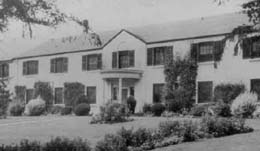On October 5, 1924, osteopathic physician Dr. William Earl Waldo (1885-1962) opens the Waldo Sanitarium at 8511 15th Avenue NE in Seattle's Maple Leaf neighborhood, immediately outside Seattle's city limits. Designed by Seattle architect Paul Richardson (1888-1939), the building overlooks the Maple Leaf reservoir with territorial views of the Olympic and Cascade Mountains and downtown Seattle.
Osteopathic physicians view the body as a whole, with particular emphasis on the musculoskeletal system. Osteopathic practice in Washington was legalized on March 18, 1909, but at the time Waldo Sanitarium opened none of the hospitals in Seattle would grant osteopathic physicians privileges to admit patients. At the time the Waldo Sanitarium was being planned and constructed there was some public controversy over whether it could legally be built so close to an open reservoir.
Ideal Surroundings
Dr. Waldo described his venture in an article in The Seattle Times at the time the Waldo Sanatorium opened:
"Our aim is not to conduct a hospital, although provision is made for surgery, but rather a place where patients can have rest, diet and quiet. Diet is stressed at all times and we strive to teach people how to live so that they may avoid many of the ills that flesh is heir to. We do not take contagious cases or those with mental ailments, nor do we take drug addicts. It has been our aim to provide a place where osteopathy, conservative surgery, medicine, hydro and electric therapy and diet can be practiced under ideal surroundings" ("New Sanitarium Opens Today — Most Modern Features Found").
Waldo Sanitarium was certified to train interns beginning in 1927. In 1937 Dr. Waldo reorganized the Waldo Sanatorium as a nonprofit facility, renaming it the Waldo General Hospital. In 1959 a major addition, designed by the firm of Naramore, Bain, Brady, and Johnson (NBBJ), was added to the building's north side. Waldo Hospital granted practice privileges to osteopathic, naturopathic, and allopathic physicians. A 1960 article in the Seattle Post-Intelligencer described Waldo Hospital as "a million-dollar institution ... with a staff of 60" ("Living Builders of Seattle: Dr. Waldo's Dream Came True").
Dr. William Earl Waldo
One of a family of 13 children, William Waldo was born in Muncie, Indiana, in on July 25, 1885. After receiving his degree from the Kirksville College of Osteopathy and Surgery in Kirksville, Missouri, Dr. Waldo moved to Seattle in 1910. He practiced first in Columbia City, and then in downtown Seattle. From 1918 to 1929, he saw patients from an office in the Joshua Green Building.
Dr. Waldo, a leading member of numerous civic organizations including the Seattle Rotary and the Municipal League, provided free medical services to student athletes at Queen Anne, West Seattle, and Broadway High Schools. He served as team physician to the University of Washington football team and the Seattle Indians Baseball Club. Dr. Waldo also served terms as president the King County Osteopathic Association, the Washington State Osteopathic Associations, and the American Osteopathic Association, of which he was a founder. A 1961 profile of Dr. Waldo in The Seattle Times noted that in his career he had delivered 2,403 babies in Seattle. He died on November 11, 1962, at Waldo Hospital.
Life After Waldo
Shortly after Dr. Waldo's death the Waldo Hospital was relocated to a newer building near Northgate Mall. The hospital closed in 1985. In late 1968, Camp Fire USA of Central Puget Sound purchased the 15th Avenue NE building, using it as the organization's headquarters until 2006 when Prescott Development negotiated an option to purchase the 1.6-acre property. Included on the property was a grove of approximately 75 trees, mostly Douglas fir, serving as an urban forest and habitat for eagles.
On March 8, 2007, the Maple Leaf Community Council, endorsed by the Sierra Club and the Seattle Audubon Society, petitioned the Seattle Landmarks Preservation board to designate the Waldo Hospital and its landscaped site a City of Seattle Landmark. On June 20, 2007, following significant community debate, expert testimony, and public comment from speakers such as Dr. Waldo's granddaughter Nancy Waldo Smith and former Washington governor Gary Locke (both against landmark status) and passionate Maple Leaf residents bolstered by Washington Trust for Historic Preservation president Chris Moore (in support of landmark status), the Seattle Landmarks Preservation Board voted to deny Waldo Hospital landmark status.
On June 22, 2007, the Seattle Post-Intelligencer announced that developers had applied to the city of Seattle for permission to demolish Waldo Hospital and build 40 homes and townhomes.

